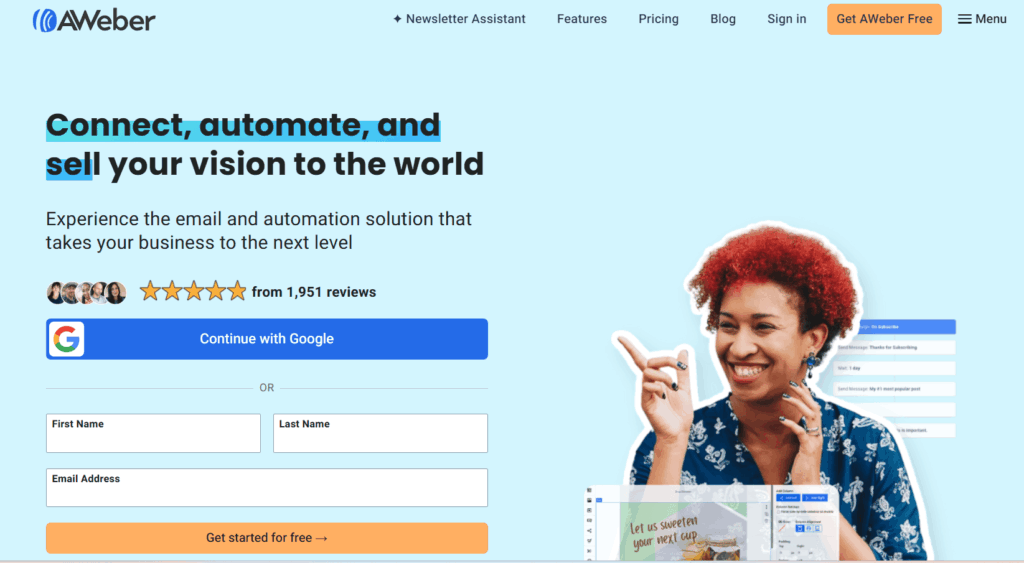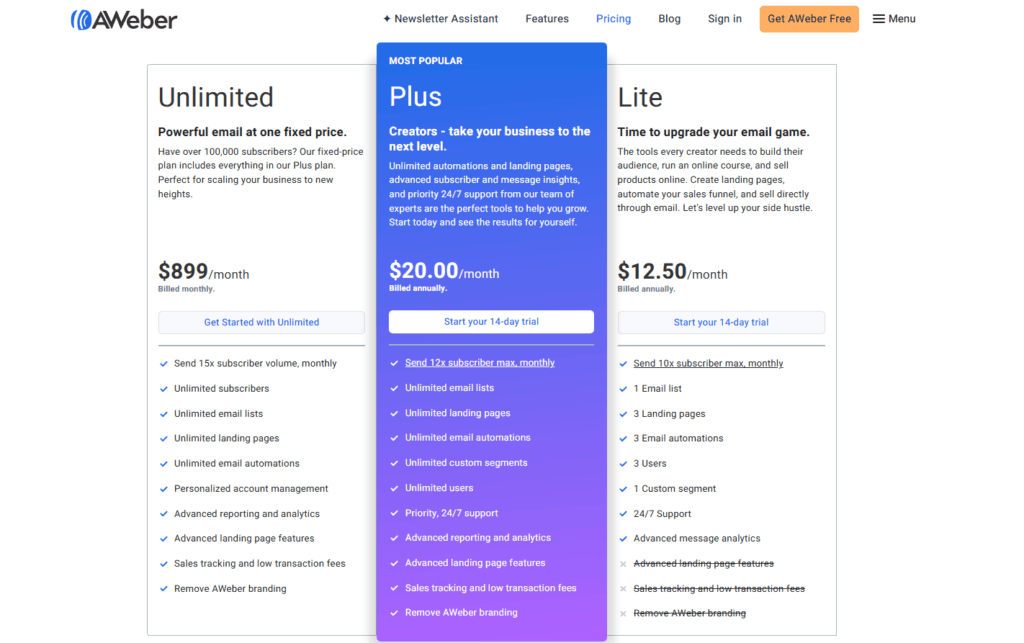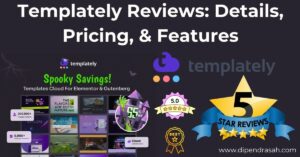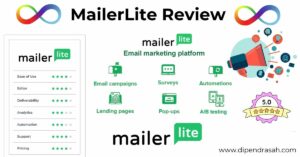
If you’ve ever looked into email marketing tools, there’s a good chance you’ve come across AWeber. It’s been around since 1998, which makes it almost ancient in online marketing years. But what actually makes AWeber worth considering in today’s crowded email marketing space? I’m breaking things down from my real experience, with all the good, the bad, the pricing, and what you can actually get out of it.
Here’s a quick snapshot of how I’d rate AWeber:

- Company Name: AWeber
- Website URL: www.aweber.com
- Price: Free plan available, Lite from $12.50/mo, Plus from $20/mo, Unlimited from $899/mo
- Founder: Tom Kulzer
- Users: Over 1 million small businesses and entrepreneurs
- Overall Rating: 4.4/5
- Trustpilot Consumer Rating: 4.0/5 (as of 2024)
- Best For: Small businesses, bloggers, starters
- Integrations: 800+ (Shopify, WordPress, PayPal, etc.)
- Mobile App: Yes (iOS/Android)
- Customer Support: 24/7 live chat & email
Free Trial: Yes. Try AWeber Free Here (no credit card needed for Free plan)
So is AWeber really worth it? Does it work if you’re just starting with email marketing, or does it suit pros looking for advanced automations and integrations? And how about those hot topics: pricing, free plan, what people complain about, and more? That’s what you’ll find here.
What Is AWeber Used For?
AWeber is mainly an email marketing platform. So if you want to grow an email list, send newsletters, share business updates, launch automated campaigns, or even build some pretty neat landing pages, that’s what it’s built for. I’ve used it both for client projects and personal sites, especially when I wanted something frustration free that just gets the job done without too much tech setup. Here’s what you can do with it:
- Build and manage an email list (collect and organize contacts)
- Send bulk email newsletters or simple personal broadcasts
- Automate follow-up emails (autoresponder sequences)
- Create signup forms and popups for websites
- Design landing pages for capturing subscribers
- Track opens, clicks, and basic analytics on your emails
- Integrate with shops and tools (think Shopify, WordPress, PayPal, Zapier, more)
It’s kind of like a onestop shop for starting with email marketing if you’re a small business, coach, author, or someone running a side hustle.
Key Features of AWeber That Matter
So, now let’s take a look at the features I think you’ll really like, especially if you want to do more without needing coding or advanced marketing experience.
- Drag and Drop Email Builder: Building email campaigns is simple. Just pick a template, edit in real time, and add your own branding. The drag and drop system means you don’t need any HTML/CSS knowledge, which saves a bunch of time.
- Autoresponders and Automations: AWeber’s core strength is its autoresponder. You can easily create sequences for welcome messages, nurture series, product launches, or any kind of drip campaign. There are automation triggers based on actions like opens, clicks, or specific tags added to contacts.
- Readymade Templates: There are 600+ email templates ready to go. Some look a little old school, but you’ll find plenty that still look modern (and they’re mobile responsive).
- Landing Page Builder: Their landing page builder is pretty handy. It’s drag and drop, so anyone can craft simple signup or sales pages that work with the rest of your marketing workflow.
- Forms and Popups: Creating custom opt in forms is super easy. You can add these to your site or even use their simple hosted versions for nontech sites.
- Tagging and Segmentation: Segments help you send targeted emails. For example, send a discount offer to “buyers” or a reminder to those who clicked but didn’t finish checkout.
- Integrations: AWeber connects with over 800 apps and services. So if you’re using tools like Shopify, WooCommerce, WordPress, Squarespace, PayPal, or even Zapier for more automation, you’re good.
- Mobile App: Their app lets you write and send newsletters or monitor your stats on the go.
- Reporting: You can track basic analytics on your emails: opens, clicks, bounces, and more. Not the deepest stats, but enough for most small business users.
- Deliverability: AWeber has solid deliverability. My emails always land in inboxes, not spam folders (assuming you’re sending legit, nonspammy stuff).
What I appreciate is how everything is tied together to save time. I can build a landing page, add a form, set up a welcome series, and track results all in one place.
Is AWeber an Autoresponder?
Yep, AWeber is known as one of the original “autoresponder” platforms. An autoresponder means you set up a series of automated messages that go out when someone subscribes or does a certain action (like a welcome email series, a course by email, or cart abandonment reminders).
Setting this up in AWeber is actually straightforward. Just create your series, pick the triggers (like sign up, clicking a link, being tagged, etc.), and watch the automation roll. You can pause, adjust the timing, or edit the emails at any time. It really takes a lot of hassle out of following up with your audience and keeping them engaged or moving toward your goal.
AWeber Login and Dashboard Experience
Logging into AWeber is pretty smooth (just https://www.aweber.com/login.htm). The dashboard isn’t flashy, but it makes sense even if you’re not a tech person. Here’s what the main experience is like:
- The left menu shows your lists, campaigns, subscribers, messages, signup forms, landing pages, and automation.
- The rest of the dashboard shows your most important stats (new subscribers, open rates, broadcasts sent, bounces, and growth trends).
- There’s a “quick actions” area for starting a message or campaign, adding subscribers, or building new signup forms.
- If you need help, there’s builtin chat support from almost every part of the dashboard (which I’ve used more than once for a quick answer).
It’s not fancy, but everything is where you’d expect and there aren’t any big learning walls, so you can get going fast.
AWeber Pricing Explained
AWeber offers a range of pricing that works for almost anyone, from solo creators with tiny lists to brands with massive subscriber counts. Here’s a simplified breakdown (2024 rates):
- Free: Up to 500 subscribers, 1 list, basic email features, and up to 3,000 email sends/month. Access to basic automation, a handful of templates, landing page builder, signup forms, and simple analytics. Pretty good for testing or running a small personal project.
- Lite (starting at $12.50/month billed yearly, or $16.15 billed monthly): All Free features, but with unlimited lists, 1,500 email sends/month, and 24/7 support. You get a bit more customization and the ability to remove AWeber branding.
- Plus (starting at $20/month billed yearly, or $29.99 billed monthly): Adds advanced automation, split testing, behavioral triggers, abandoned cart emails, web push notifications, tag management, advanced analytics and reporting.
- Unlimited (starts at $899/month): Designed for big senders, agencies, and large brands who want unlimited email volume, whiteglove support, and dedicated IP addresses for deliverability.
Unlike some platforms that charge for every tiny feature, AWeber’s costs are based mostly on list size and plan level. None of the plans force annual contracts; you can cancel any time. The Free plan actually covers a lot, so if you’re new to the email game, it’s a pretty risk free way to build and test an audience before paying.
AWeber Free Plan: What’s Actually Included?
The Free plan is a solid entry point. Here’s what you actually get (and what you don’t):
- Up to 500 subscribers across your account
- One list/one audience
- Send up to 3,000 emails/month
- Landing pages (with AWeber branding)
- Signup forms
- Basic templates (but still a bunch of choices)
- Basic autoresponder support (single automation sequence)
- Email support & basic analytics
What’s limited or missing compared to paid? You don’t get advanced automations, you have less segmentation, you can’t split test, and your landing pages/emails include some light AWeber branding. But honestly, for small newsletters, test campaigns, or nonprofits, Free can go a long way.

AWeber App and Mobile Functionality
The AWeber mobile app is available for both iOS and Android, and I’ve found it pretty useful for staying in touch with my lists when I’m not at the computer. Key features include:
- Write, send, and schedule emails (broadcasts only, not full automation sequences)
- Add or manage subscribers
- See stats (opens, clicks, subscriber growth)
- Get push notifications for new signups or issues
The design is clean and it hasn’t crashed on me. It’s not a replacement for the full dashboard, so if you want to design a campaign with lots of segments or go deep into stats, you’ll want the desktop version. But editing or sending on the fly? The app has saved me a few times on the go.
AWeber Review Complaints: What Real Users Dislike
No platform escapes complaints, and AWeber’s been around long enough to rack up both raves and rants. Here’s where I’ve seen most complaints pop up (including from my own experience):
- Outdated or cluttered interface in spots: While the dashboard is getting better, some menus and the legacy email builder can feel dated. I stick to the new drag and drop for everything.
- Limited automation (on lower plans): If automations are your top priority, the Free plan or Lite plan may feel too basic. Advanced automations and split test features start at Plus, so be ready for a higher price if that’s a dealbreaker.
- Email templates can look generic: There are tons to choose from, but a few feel a bit 2008ish. I always check the preview and tweak to match my branding.
- Strict compliance and double optin: If you import lists, AWeber tends to require recipients to confirm again (double optin), which not everyone loves. On the flip side, it keeps you out of spam folders, so it’s weighing safety against convenience.
- No native SMS marketing: There’s no builtin SMS/text marketing. Some competitors offer that now, but AWeber mostly sticks to email and web push.
- Tagging and segmentation not as advanced as ActiveCampaign/ConvertKit: You’ll find solid basics on segmentation but not the deep behavioral targeting of the pricier competition.
Overall, while AWeber does what most people need it to, it’s less suited if you demand cutting edge tech, SMS marketing, or advanced automation routines unless you’re on its higher paid plans.
AWeber Pros and Cons (From RealWorld Use)
Here’s how I break down what’s great about AWeber, as well as a few areas I’d love to see improved:
<strong>Aweber – Best Email Marketing For Small Business</strong>
Aweber Pros and Cons
How Well Does AWeber Deliver? (Performance and Stats)
Every email marketer cares about their emails getting delivered. In my experience, using good list practices, open rate and deliverability performs really well, usually between 98–99%. Spam issues are rare unless you’re sending bad content or importing unvetted lists. If you do, you’ll hit some snags.
Basic reports show me all the stats I typically care about (opens, clicks, bounces, unsubscribes). For more detailed insights (like which link in your email got clicked the most or who’s most engaged over a campaign), you can check out the Plus tier, but even the basics cover most needs for small to medium sized work.
Integrations: Does AWeber Work With Other Tools?
One of the things I value most is how easy it is to connect AWeber to the rest of your tech stack. Shopify, WooCommerce, WordPress, Squarespace, PayPal, Eventbrite, even Facebook—AWeber usually just needs an API key or a few clicks to hook things up. For software geeks, Zapier adds another set of connections (over 5,000 more apps), so you can custom automate all kinds of stuff.
In all my integrations so far, I have yet to see a truly frustrating setup. I’m able to make sense of it, even when I’m in a rush and just want stuff to work.
Deliverability and Compliance
This is a biggie for anyone actually wanting their emails to reach the inbox. AWeber has a long track record for getting messages delivered. A lot of that comes back to the strict double optin rules, which can be annoying if you have a legacy list but keeps your sender reputation healthy with the big email providers (Gmail, Outlook, Yahoo, etc.).
They also have builtin compliance monitoring (they’ll notify you fast if your email seems dodgy), simple tools to handle unsubscribes, and support to help with GDPR/CANSPAM compliance. While not fancy, it works and keeps lists clean, which leads to fewer headaches down the road.
Who Should Use AWeber?
If you’re running a small business, are a coach, creator, local service, ecommerce shop, or someone looking for a simple but reliable email tool, AWeber is a really strong option. The easy setup means you don’t need to hire a consultant or spend nights learning complex flows. Bloggers and solo creators will appreciate the free plan and landing page builder, while small online shops can make use of the automations like abandoned cart and purchasebased triggers (with Plus tier).
Larger teams, aggressive SaaS companies, or marketers who want advanced CRM or SMS will probably find it not robust enough. But for entry level and small business, it’s a workhorse that’s hard to mess up.
Support and Help Resources
AWeber offers solid support:
- 24/7 live chat (my favorite, usually under 5 minutes wait)
- Email support and ticket system
- Lots of online tutorials, webinars, and a searchable knowledge base
- Community forums for sharing tips or asking for feedback
I’ve used chat support a few times (especially on weekend projects) and always had real answers, not just canned scripts. That’s rare and makes the platform welcoming if you need help.
Experience Using the Platform (My Anecdotes)
When I first tried AWeber, I was working on an email series for a local nonprofit and wanted something nontechnical that wouldn’t cost us cash up front. The Free plan got us started; building our list, getting volunteer signups, sending newsletters, and we only needed to bump to paid when things grew past 500 subscribers. It took less than an hour to get the first campaign up (way less time than with Mailchimp or Constant Contact in my opinion), and every email went out reliably.
I’ve recommended it to a handful of local businesses since, like a restaurant wanting to promote deals and a small coaching group needing automation. Every time, it’s been easy to set up, simple to teach new folks, and I’ve seen consistently solid deliverability.
Comparing AWeber to the Competition
It’s always good to see how a tool stacks up against the main players. Here’s a quick rundown of AWeber vs its most common rivals:
- Mailchimp: Mailchimp is more popular but recently made its free tier much less generous and has gotten pricier over time. AWeber still gives you basic automations on free, and is generally simpler to use for basic campaigns.
- ConvertKit: ConvertKit is made for creators, with very strong tagging and segmenting. If you need advanced automations and are willing to pay (and have 1,000+ subscribers), ConvertKit feels “smarter.” AWeber is better for simpler use cases and smaller budgets.
- ActiveCampaign: Probably the best for power users who need sales automation, CRM, SMS features; if you’re a big team or have deep funnels. But it’s pricier and requires some learning curve. AWeber is easier for basics.
- Constant Contact: Another longtime competitor, but I find their interface a little more old school and less intuitive. Pricing is higher on average.
- GetResponse: Powerful features at matching price to AWeber, but heavier learning curve, especially for full automation. Great if you want webinar hosting or other fancy add ons.
Basically, if simplicity and cost matter most, and you don’t need the latest features, AWeber’s a good balance of value and reliability.
Final Thoughts: Is AWeber Worth It?
If you’re wondering “Is AWeber worth it?” I’d say it depends how much you value simplicity, deliverability, and easy support over having every bleeding edge marketing gadget. For solo pros, bloggers, small shops, or anyone just looking to build a healthy list and not overthink it, it’s a solid buy. The Free plan is generous for newbies, and the jump to paid isn’t a budget buster.
If you’re a marketing agency or a brand looking to spin up massive, complex automations or want SMS/text marketing or deep CRM, you’ll probably feel the limits at some point. For everyone else, you’ll find a helpful, userfriendly toolkit, decent support, and plenty of features to grow an audience reliably.

FAQs About AWeber
Is AWeber worth it?
If you want a budget friendly, “it just works” email tool for small lists, small businesses, or growing projects, AWeber is worth checking out. High deliverability and a really simple email builder make it stand out for nontech folks.
What is AWeber used for?
AWeber is used for building email lists, sending newsletters, creating automation (autoresponder) campaigns, launching landing pages, and tracking basic customer engagement. It’s ideal for coaches, bloggers, small shops, or anyone wanting to run email marketing without too much fuss.
How much does AWeber cost?
The Free plan costs nothing (up to 500 subscribers, 3,000 emails/month). Lite starts at $12.50/month (annual payment). Plus (for advanced automations/analytics) is $20/month (annual). Agencies or large senders looking at Unlimited will pay from $899/month. Pricing is based on list size; add ons and overages cost more.
Is AWeber an autoresponder?
Yes! AWeber is one of the original autoresponder email providers. You can easily set up automated welcome series, nurture flows, and trigger based follow ups with little hassle, especially once you get the hang of the workflow builder.
What complaints do people have about AWeber?
Main complaints involve some legacy UI parts feeling a bit dated, basic automation rules on the free/lower plans, and less advanced segmentation than super high end tools. Some people dislike the enforced double optin for certain imports, as it adds a hurdle for list migration.
How do I log in to AWeber?
Just go to https://www.aweber.com/login.htm and use your credentials. If you ever get stuck, the password reset tool or support chat is easy to find and responsive.
What’s the AWeber App like?
The app is straightforward, lets you check stats, add/manage subscribers, and send simple email blasts. Great for updates and simple management, but you’ll want the main site for advanced campaign setup.
Getting Started With AWeber
Signing up doesn’t require a card, and you can have a live, working list and your first campaign up and running within about 30 minutes. It’s worth a free test drive if you’re looking for something simple, with the option to scale up if you like what you see.

That covers just about everything you’ll want to know before making a decision about AWeber in 2024. If you have specific questions or want to see screenshots of a certain feature, just reach out. Happy to share my experience and check out realworld cases!



